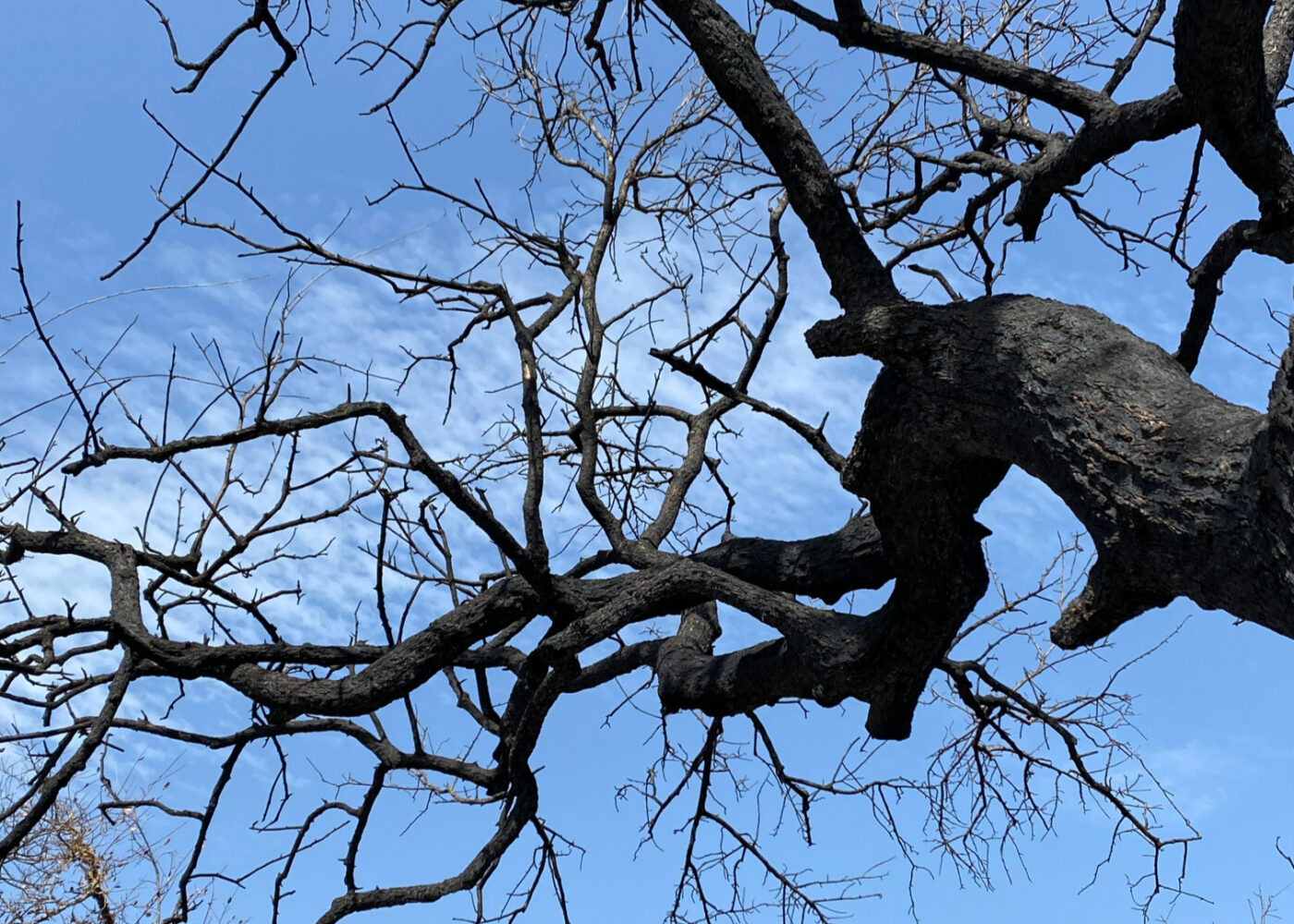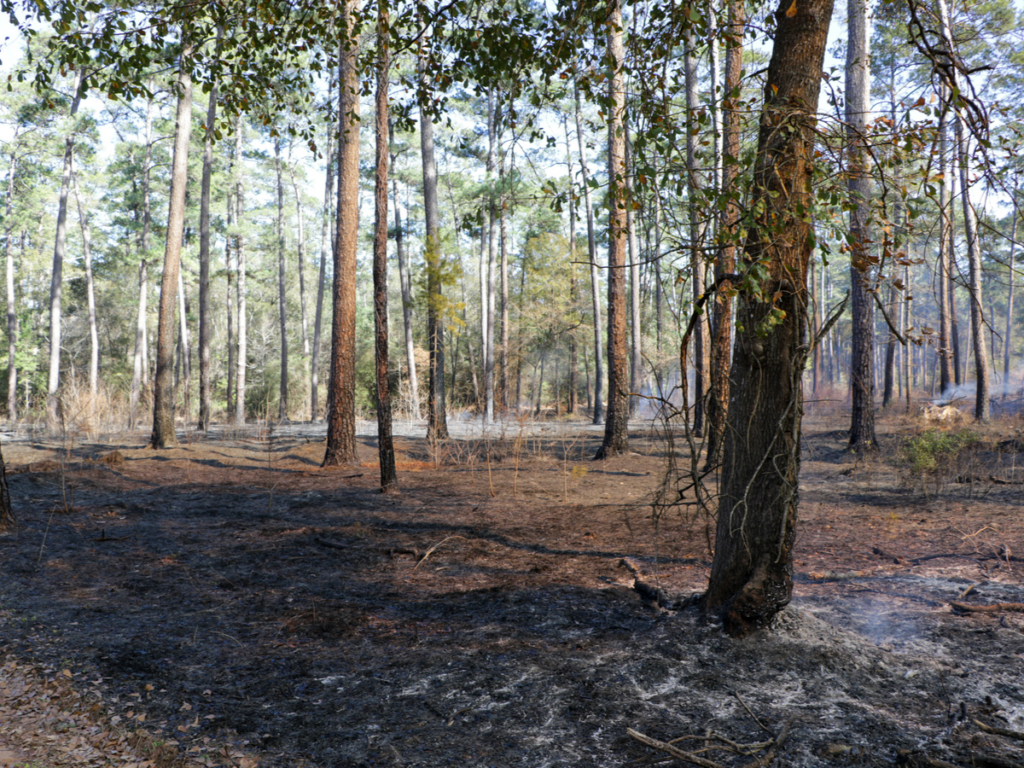One of the first questions we get after a fire is “will my tree survive?” After a wildfire, you may see trees with brown leaves or damage to the canopies, charring on trunks, or bark cracking and separating from the trunk.
Many trees affected by wildfires will survive, but some may not and will need to be replaced. Read more about reforestation after a fire.
Determine post-fire tree health
Is there severe damage to the main trunk of the tree?
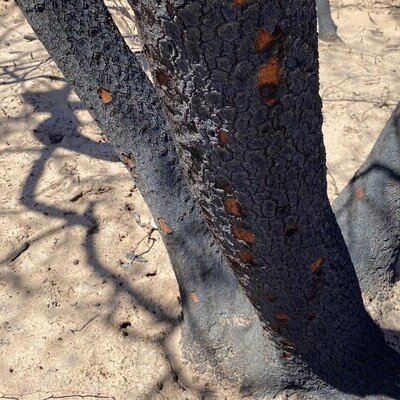
If you see large areas where the bark is split and starting to peel the damage is severe.
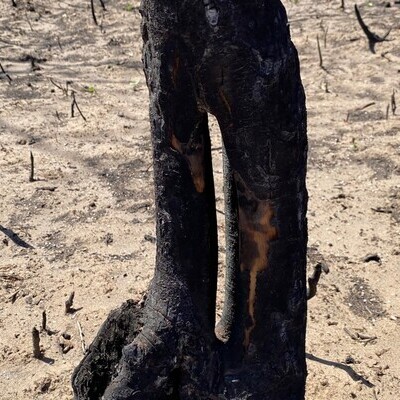
Underneath the bark is a thin layer called the cambium. The cambium is where tree growth takes place. If this layer has been severely damaged, the tree will not survive.
Have the leaves in the canopy turned brown and dry?
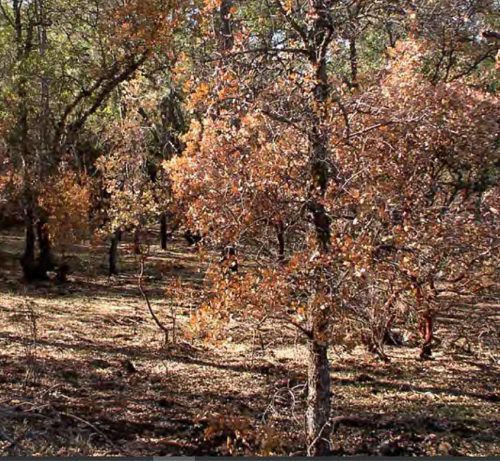
A brown and dry canopy is caused by heat scorching. This does not show severe damage to the tree, and it will usually recover if the trunk is still healthy.
What size tree do you have?
Larger trees have thicker bark making them more fire resistant since that thick bark acts as a protective layer. Smaller trees have thinner bark with not as much protection from the heat or direct flames from the fire.
Hardwood vs. pines and other evergreens
Hardwood and evergreen trees have different characteristics that will show us clues to how much damage they received during a stressful event, such as a wildfire.
Hardwood trees
- Have large (broad) leaves and fruit. They are deciduous, meaning they lose their leaves every year during dominancy. Common hardwoods in Texas are oaks, pecans, elm, sweetgum and cypress.
- Often hardwoods will recover from 100% scorch during periods of normal rainfall if the roots, stem and buds in the crown are uninjured.
- If there is significant damage to the vascular system in the roots, stem or crown the tree will likely die.
- Evidence of one of these factors is indicative of a dead or dying hardwood tree:
- Bark has cracked or separated on all sides of the trunk.
- Signs of wood-boring or bark beetles on any part of the stem.
- Scratching through inner bark on all four sides reveals dark or yellowish cambium layer, which indicates it has died. A living cambium layer will be a white or pink color.
- There are no green leaves present in the crown two months after the fire and beyond.
- Evidence of two or more of these factors is indicative of a dead or dying hardwood:
- There are no green leaves present in the crown, and more than 25% of the crown has been consumed.
- There is bark char with the reduction of bark thickness on all sides of the trunk.
- All of the organic material has been consumed causing a sunken basin effect around tree.
- The large lateral roots have been exposed and charring has occurred in two or more quadrants around the tree.
Pines and other evergreen trees
- Are trees that have green leaves or needles year-round and only shed the old foliage once the new foliage has been completely formed. Common pines and evergreens of Texas are pine, juniper, magnolia and Texas mountain laurel.
- Often hardwoods will recover from 100% scorch during periods of normal rainfall if the roots, stem and buds in the crown are uninjured.
- If there is significant damage to the vascular system in the roots, stem or crown the tree will likely die.
- Evidence of one of these factors is indicative of a dead or dying pine or evergreen tree:
- Bark char is greater than 50% of stem height on all sides.
- Any sign of wood-boring or barking beetles on any part of the stem.
- There are no green needles or leaves present in the crown 2 months after the fire and beyond.
- Evidence of two or more of these factors is indicative of a dead or dying tree:
- No green needles or leaves present in the crown.
- All of the organic material has been consumed causing a sunken basin effect around tree.
- The large lateral roots have been exposed and charring has occurred in two or more quadrants around the tree.
- Bark char is greater than 25% of stem height on all sides.
- Resin is weeping or bleeding from more than 25% of the stem circumference.
When does a tree need to be removed?
- The tree trunk is smaller than 6 inches in diameter and has severe damage around the base.
- The tree trunk is 6-12 inches in diameter and has significant damage to the canopy and the trunk has been damaged.
- The tree trunk is over 12 inches in diameter and has lost significant bark thickness and you can see parts of the underlying wood.
- The tree is near a structure, and it has wounds on at least half of the trunk and is at risk of failure and causing damage.
When can a tree stay?
- The tree lost all the leaves in the canopy but there was minor damage done to the trunk and the canopy.
- The tree trunk diameter is at least 12 inches and did not have any reduction in bark thickness.
- Leave dead-standing trees that don’t threaten safety or structures—they serve as a food source for woodpeckers and other insect-eating species and can also provide shelter for cavity-nesting birds and small mammals.
Caring for the trees that survived
Watering
The best thing you can do for your most valued trees affected by fire is to give them water. Most of a tree’s root system is in the top 3 feet of soil. Meaning the roots are prone to dehydration from the heat of a fire. Water should be focused on the dripline of the tree canopy. Soak the top 15 inches of the soil with a hose over a long period of time or with a soaker hose.
Mulching
Mulch can be spread over this area to help regulate temperature and soil moisture. Mulch should not be deeper than 2-3 inches and up to but not touching the trunk of the tree.
Monitor for beetle damage
When trees have been stressed or damaged it decreased their defenses against wood boring insects. Therefore, you will want to monitor your trees health for signs of borers, and if the tree does become infested you can decide to either treat the beetles or have the tree removed.
Fire fungus
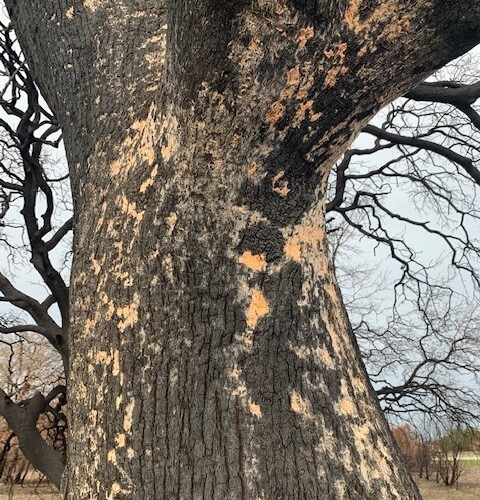
Wildfire can have dramatic impacts on landscapes. Fire can kill vegetation, but it can also create new conditions that allow other organisms to live. One of these organisms is Fire Fungus.
This fungus appears within weeks after a wildfire and grows mainly on the trunk and lower branches of some trees. The color of the fungus can vary from white to creamy to an orange hue. Fire fungi’s unique adaptations take advantage of the conditions left after a fire.
There are dozens of species of fire fungi that have been seen growing on trees worldwide after a fire. According to several sources, these fungi have descriptive names, such as anthracophilous (coal loving), pyrophilous (fire-loving), or carbinicolous (coal inhabiting). They all have some attributes in common. Their spores, or reproductive structures, may be stimulated to grow by heat from the fire. The chemical nature of the bark changes following a fire, allowing a favorable nutritional environment for the growth of these organisms.
Not all trees in an area will be affected, but the growth may continue to spread to the effected trees for months after the fire. These pioneer fungi will serve as decomposers, providing nutrients back into the environment for the next wave of microbes and plants.
The after-fire fungi pose no threat to humans or animals, nor will they cause harm to the surviving trees in the area. They are one of the first steps in the recovery of the ecosystem toward a renewed, productive forest and should be viewed as evidence of the resilience of nature, even under the most catastrophic circumstances.
